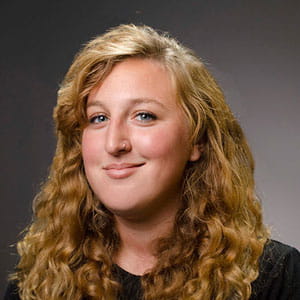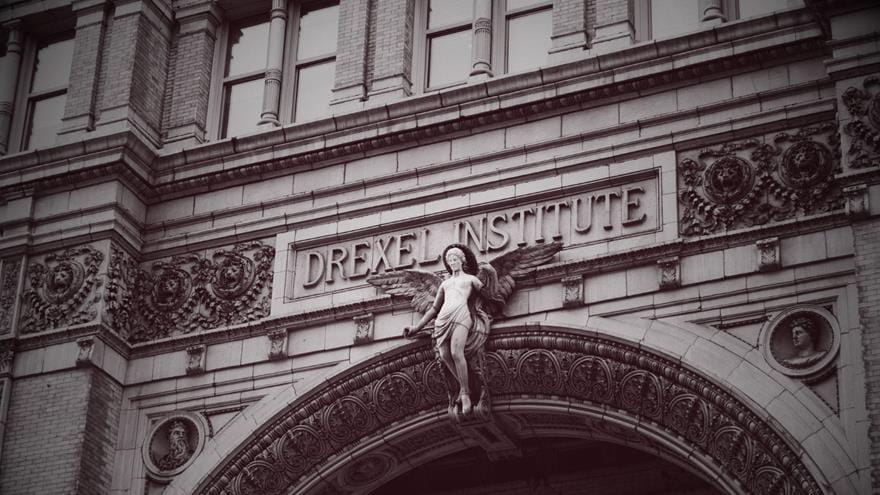Drexel NOT in Philly: The Founder’s America

Last term, a series of “Drexel in Philly” articles highlighted places where Drexel University founder Anthony J. Drexel (1826–1893) left his mark in Philadelphia’s Old City, Center City, Fairmount Park and West Philly neighborhoods.
This follow-up article explores the notable places outside of Philadelphia where the philanthropist and financier built and supported institutions that benefitted the neighboring communities.
There are several places you can visit today that bear some trace of Anthony:
- The site of Wall Street’s “Drexel Building” (New York, New York)
- The former Childs-Drexel Home for Union Printers (Colorado Springs, Colorado)
- The Church of the Presidents (Long Branch, New Jersey)
- The oldest public sculpture in a Chicago park (Chicago, Illinois)
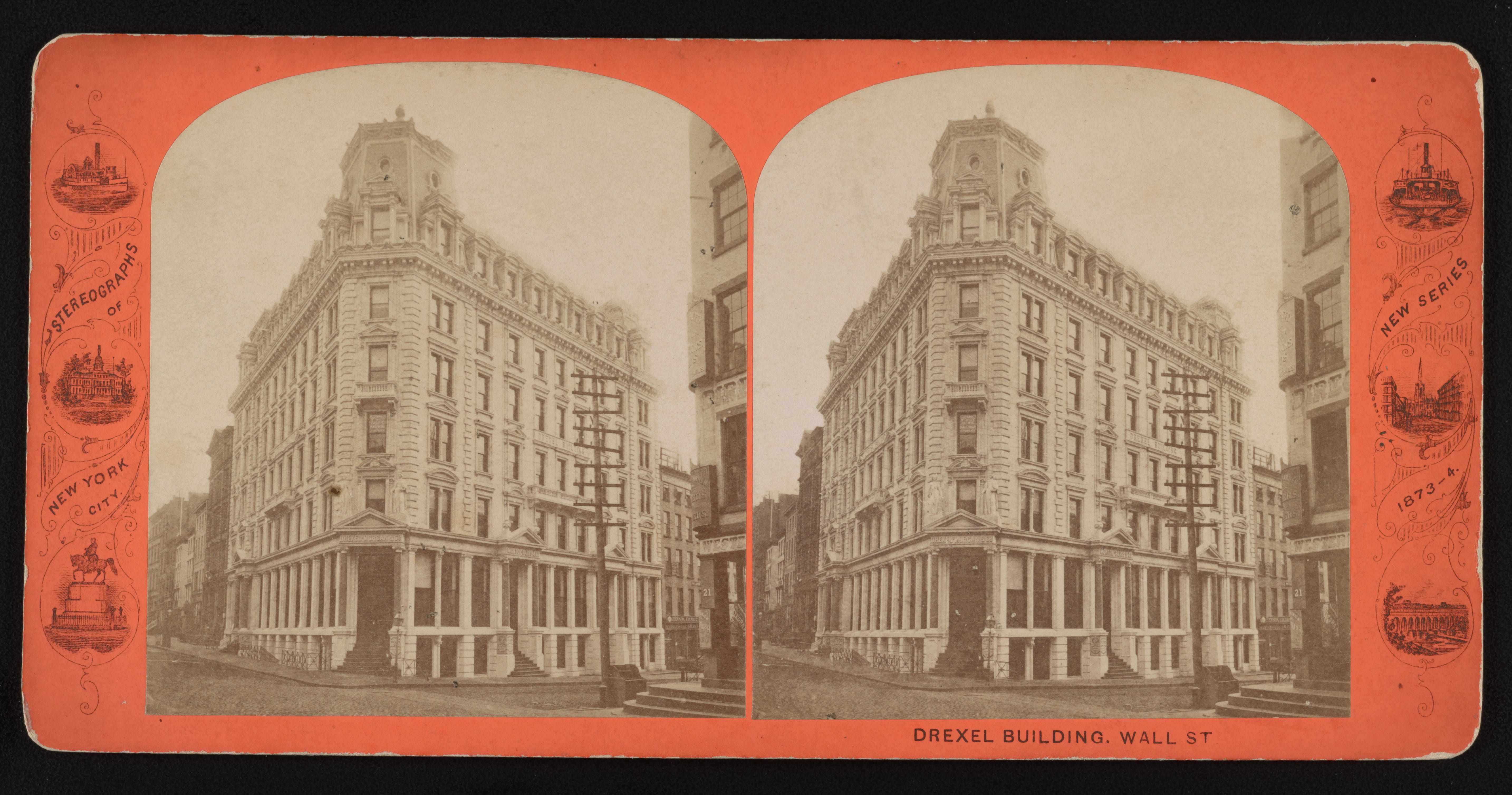
A late 19th century stereograph card showing the Drexel Building on Wall Street. Photo courtesy the Library of Congress.
The Site of Wall Street’s “Drexel Building”
Anthony led the Philadelphia-based Drexel & Co. private bank that expanded its influence around the world, financing the railroad industry and bailing out governments. Working alongside his father and two brothers, he also mentored junior partner John Pierpont "J.P." Morgan, who became an influential Gilded Age tycoon.
Pierpont’s father, Junius Spencer Morgan, had partnered with the Paris-based Drexel & Co. office to transfer the proceeds of war bonds his Morgan & Co. bank had sold to the French government during the Franco-Prussian War (1870–1871). When Anthony later asked him for advice to strengthen Drexel & Co.’s presence on the burgeoning Wall Street in New York City, Junius saw a mutually beneficial opportunity.
At that time, the Drexel & Co. locations in New York, Philadelphia and Paris had active means of about $3 million ($74 million in 2025), and Anthony and his older brother Francis “Frank” Anthony Drexel were worth about the same; for comparison, Junius was worth more than $5 million ($123 million today) and Pierpont about $350,000 ($8.5 million). Pierpont was so burnt out as a junior partner at Morgan & Co.’s New York office that he wanted to leave the industry, but Junius recommended him to lead Drexel & Co.’s New York office, thinking he could benefit from a strong mentor like Anthony, who was 11 years older. Pierpont and Anthony partnered to create Drexel, Morgan & Co., which Pierpont led (youngest Drexel brother Joseph Wilhelm worked under him) as Anthony and Frank managed the Philadelphia Drexel & Co.
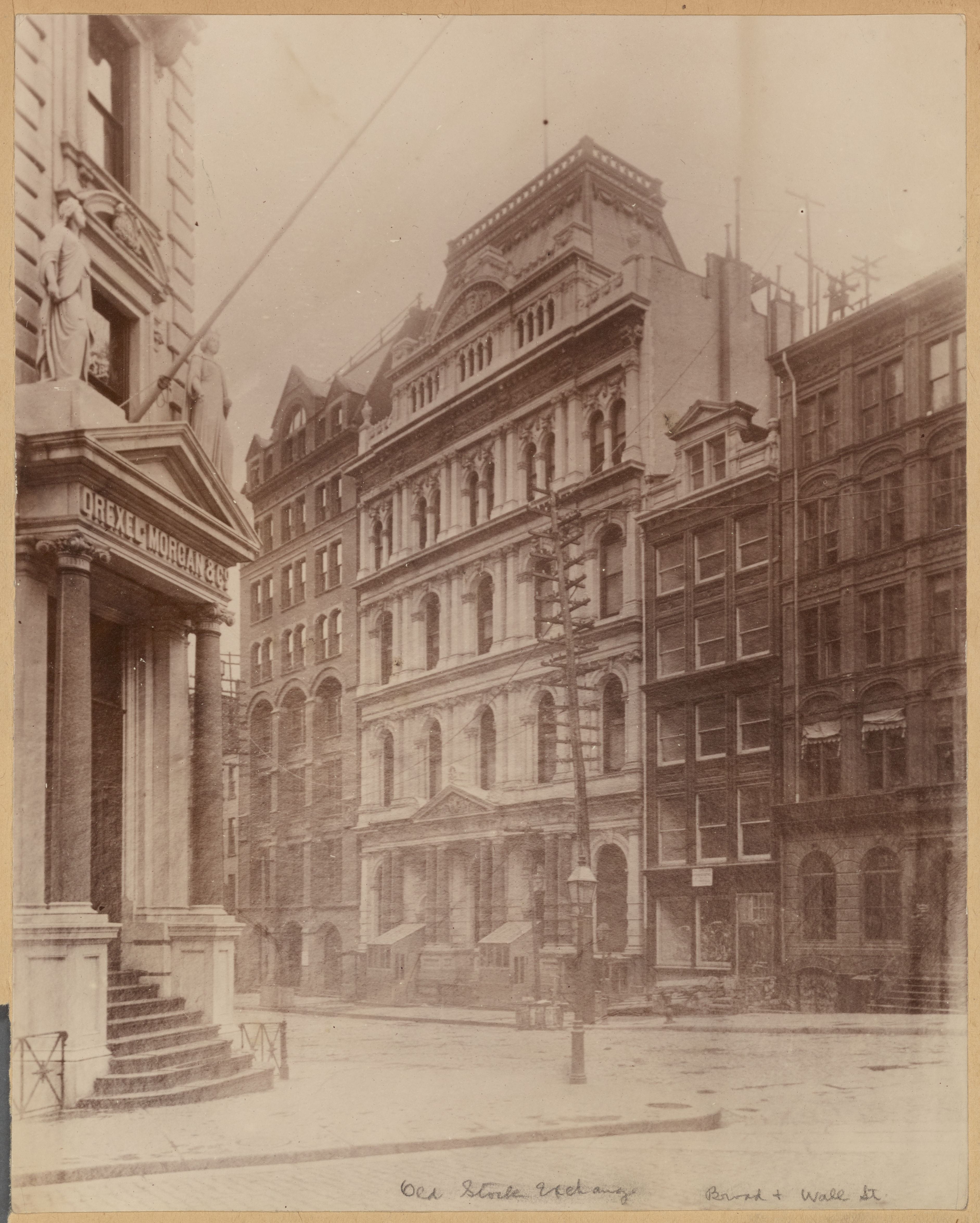
An 1875 photograph showing the Drexel, Morgan & Co. building (note the name above the entryway on the left). Photo courtesy of the New York Public Library's Irma and Paul Milstein Division of United States History, Local History and Genealogy in the New York Public Library Digital Collections.
Drexel, Morgan & Co. opened in 1871, and while Pierpont took a 15-month vacation abroad for his health, the Drexels bought the office’s new home at 23 Wall St., facing the New York Stock Exchange and Federal Hall. The land was purchased for $945,000 in gold, including $250,000 for a 717-square-foot property (a real estate record that lasted 33 years). The ornate, six-story marble building with a catercorner entrance opened in 1873 and became known as “the Drexel Building”. It also housed other tenants, including a firm owned by future U.S. Vice President Levi Morton. For a time, it was the tallest building on Wall Street as well as one of the city’s first to have an elevator and, later, electricity, thanks to Drexel, Morgan & Co. client Thomas Edison.
The successful and powerful Drexel, Morgan & Co. remained at 23 Wall St. until Anthony died in 1893. His estate and heirs managed the Drexel building for another two decades before selling it to Pierpont in 1912 for about $3 million (worth $99 million today). Pierpont had leased space there to run the renamed J.P. Morgan & Co. (which later grew into JPMorgan Chase, now America’s largest bank).
He died a year later and never saw the new building that still stands today (even after the 1920 Wall Street bombing). Now vacant for over a decade, the building remains a popular tourist destination, partly because of its location and the “Fearless Girl” statue outside of it.
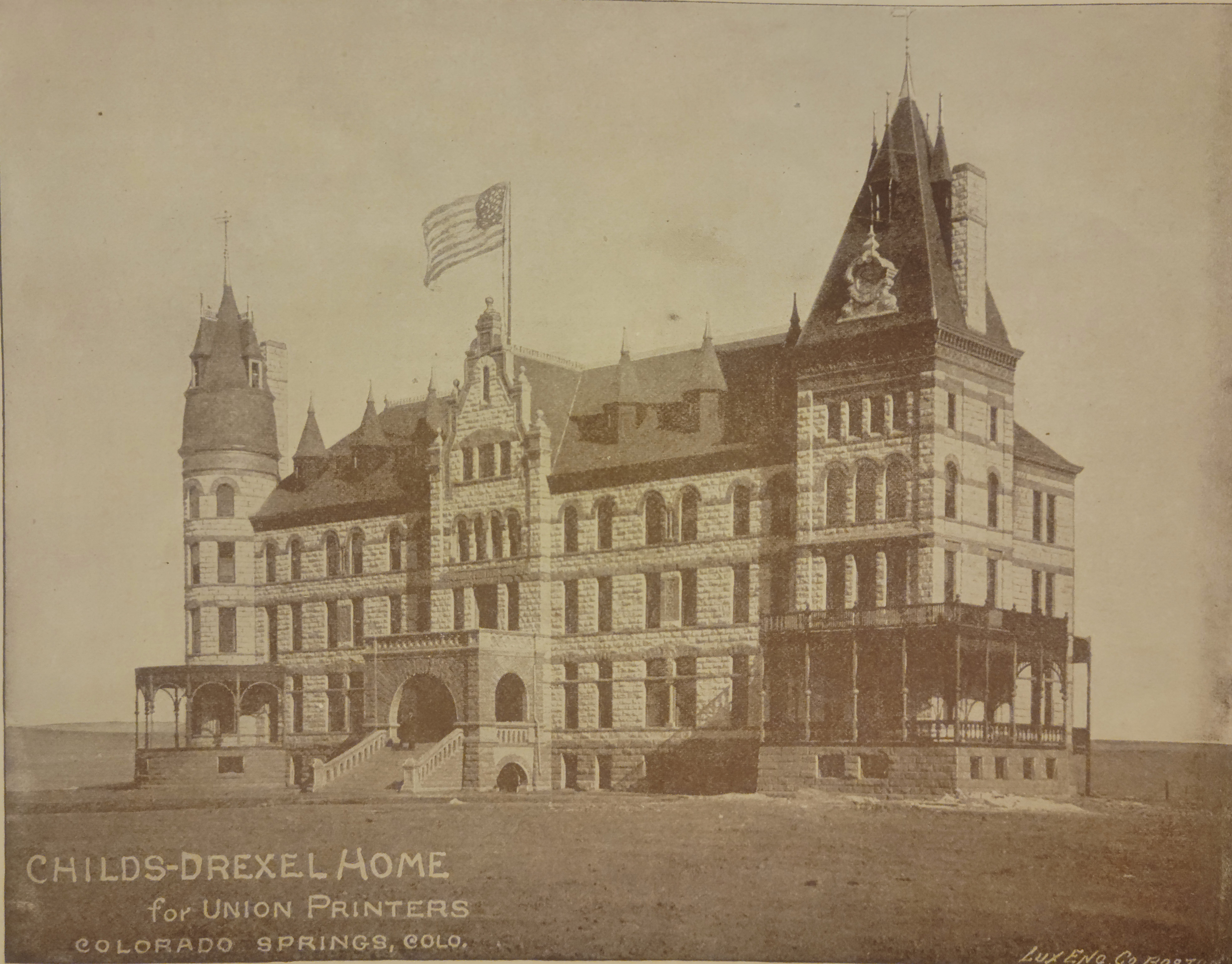
The Childs-Drexel Home at the time of its founding. Photo courtesy of Union Printers Home at Printers Hill.
The Former Childs-Drexel Home for Union Printers (Colorado Springs, Colorado)
While working at Drexel & Co. for about 55 years, Anthony spent three decades as a silent co-owner of one of Philadelphia’s leading newspapers. Another co-owner was the editor and publisher George W. Childs, Anthony’s lifelong partner in business, friendship and everything in between (Anthony even named his youngest son George W. Childs Drexel).
In 1864, they purchased the struggling Public Ledger newspaper for an estimated $20,000 (about $410,000 today). Childs managed day-to-day and editorial operations and procedures, quickly turning the newspaper into a profitable and influential enterprise. A state-of-the-art office building was built on 6th and Chestnut streets in 1868 with its own on-site printing office and printing press room (its replacement still stands today).
Back then, printers had one of the most physically demanding jobs in the newspaper industry, and they organized into regional unions later integrated into the International Typographical Union (ITU) in 1869. At ITU’s 1886 convention, Childs announced that he and Anthony were donating a no-strings-attached gift of $5,000 each (a combined $10,000 worth about $342,000 today):
[I]t is my earnest desire — a desire in which I am heartily joined by my friend, Mr. A. J. Drexel — to extend to the time-honored International Typographical Union, as the representative of the united craft in North America, some expression more substantial than words. How to do this in a way that may produce lasting good has engaged the thoughts of both Mr. Drexel and myself; and we conclude that your union … will know better than ourselves how that good can be best accomplished.
ITU used the donation to start a fundraising campaign to build a permanent convalescent home and treatment facility for printers. For years, union members contributed to the “Childs-Drexel fund,” with those living east of the Mississippi donating on Childs’ birthday on May 12 and those to the west on Anthony’s birthday on Sept. 13. Ultimately, an additional $70,000 (about $2.5 million today) was raised.
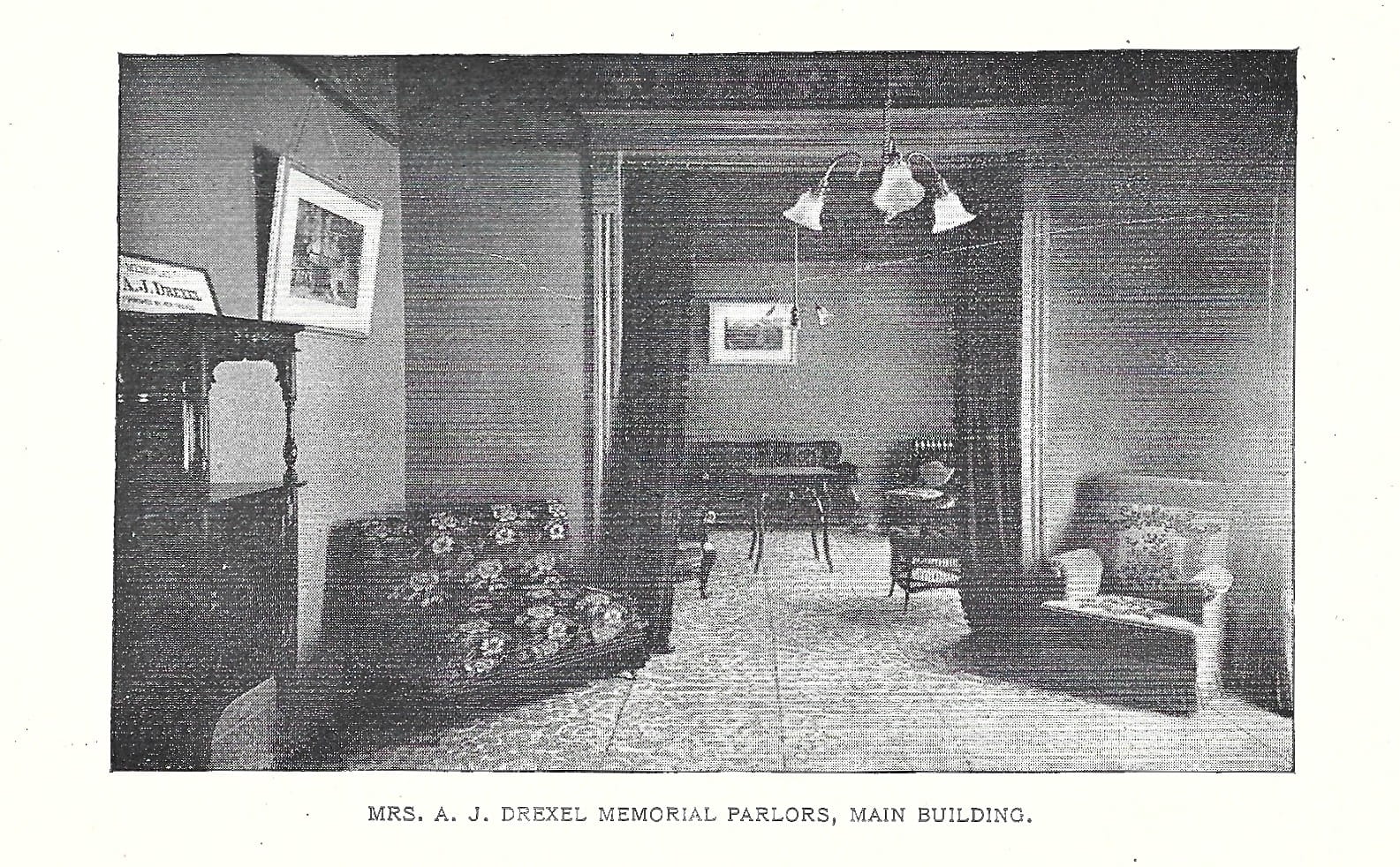
An undated scanned photograph of the Mrs. A.J. Drexel Memorial Parlors — note the sign on the left in the Childs-Drexel Home for Union Printers. Photo courtesy of Union Printers Home at Printers Hill.
The same year Anthony founded today’s Drexel University in 1891, the five-story Childs-Drexel Home for Union Printers opened on 80 acres of land in Colorado Springs, Colorado, an area known for its holistic healing properties and nature. It was dedicated on Childs’ 63rd birthday on May 12, 1892. Childs traveled over 10,000 miles in a special train car during his first-ever trip out west to attend the ceremony, but Anthony did not attend (it’s unknown why, or if he ever visited the Home). However, he was among the well-wishers who sent off Childs in Philadelphia; U.S. President Benjamin Harrison and Vice President Levi Morton (the former Drexel Building tenant) sent telegrams wishing him a safe trip. During the ceremony, trees were planted in honor of Childs and Anthony, among other dignitaries.
The Home’s original white lava stone and red sandstone Renaissance-style building had panoramic views of the Rocky Mountains. Its 75 rooms included porches, parlors, reception rooms, bed chambers, a kitchen, pantries, a dining room and a library. Some of the parlors and rooms honored Childs’ wife Emma Bouvier Peterson Childs and Anthony’s late wife Ellen Rozet Drexel.
Originally housing 30 residents at a time, the institution grew to house 500 residents on 100,000 square feet of property with additional buildings, including a hospital and the ITU headquarters. In 1902, the Childs-Drexel Home for Union Printers became the Union Printers Home but, like the ITU and printing itself, its power and membership dwindled over the years. ITU shut down in the 1980s, selling land and closing buildings on the property, and the Home took on non-ITU residents. In 2014, it was sold to a large private nursing home organization that closed in 2020. The next year, the available property and buildings were purchased by local residents working to revitalize the area as a mixed-use property while preserving its historic legacy.
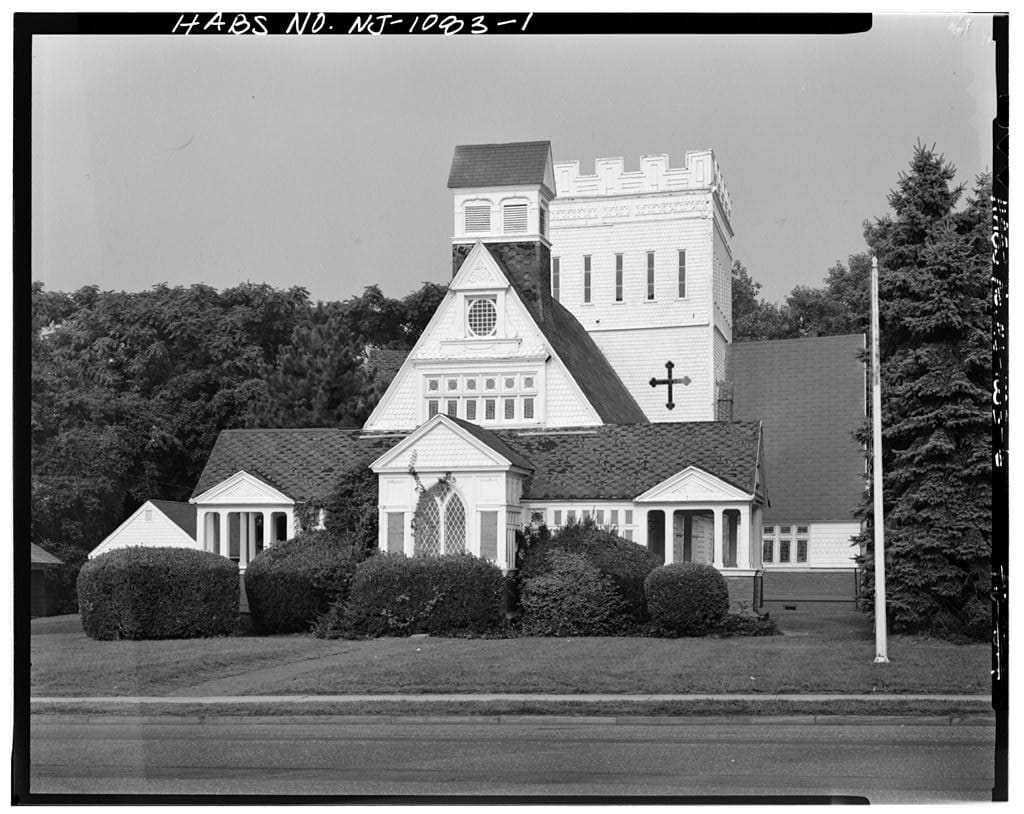
An undated photo of the Church of the Presidents, believed to be taken after 1933. Photo courtesy the Library of Congress.
The Church of the Presidents (Long Branch, New Jersey)
For decades, Anthony vacationed with friends and family in Long Branch, New Jersey, which consequently gained a reputation as a Gilded Age resort destination.
Anthony first began vacationing in Long Branch in the 1860s and summered there for decades. He’s mentioned in period newspaper articles as an original stockholder of the Long Branch Gas Company; an early contributor of books to the local library; and an attendee of various civic meetings about ocean bluff protection and real estate development.
Childs also vacationed there, and they introduced their friend Ulysses S. Grant, the Civil War hero and future U.S. president, to Long Branch. Grant spent all eight summers of his presidency at his “summer White House,” popularizing Long Branch as “the nation’s summer capital” when his cabinet accompanied him. Succeeding U.S. presidents Rutherford B. Hayes, James A. Garfield and Chester A. Arthur also vacationed in Long Branch; Benjamin Harrison, William McKinley and Woodrow Wilson did too. Many attended Mass at the St. James Episcopal Chapel, which opened in 1879 and was cofounded by Anthony (one of the original vestrymen) and Childs, among others. Anthony helped install former Kenyon College president Reverend William Budd Bodine, DD, as a rector; Bodine later led the Philadelphia Episcopal Cathedral (where Anthony was similarly involved and attended services) and said the prayer at the funeral services of Anthony and Childs.
For years after Anthony’s death, a “Drexel memorial service” was held at St. James Episcopal Chapel. Plaques for Anthony and Childs were installed in recognition of their involvement; they themselves contributed a brass tablet in memory of Grant, and other plaques commemorated the presidents who worshipped there.
After the church was deconsecrated in the 1950s, the ownership of the land reverted back to the chapel’s original benefactors; Drexel descendants, along with those from other founding families, turned over their rights to the Long Branch Historical Museum, which began operating the building as the “Church of the Presidents.” The interior has been going under renovations for many years and is not open to the public.
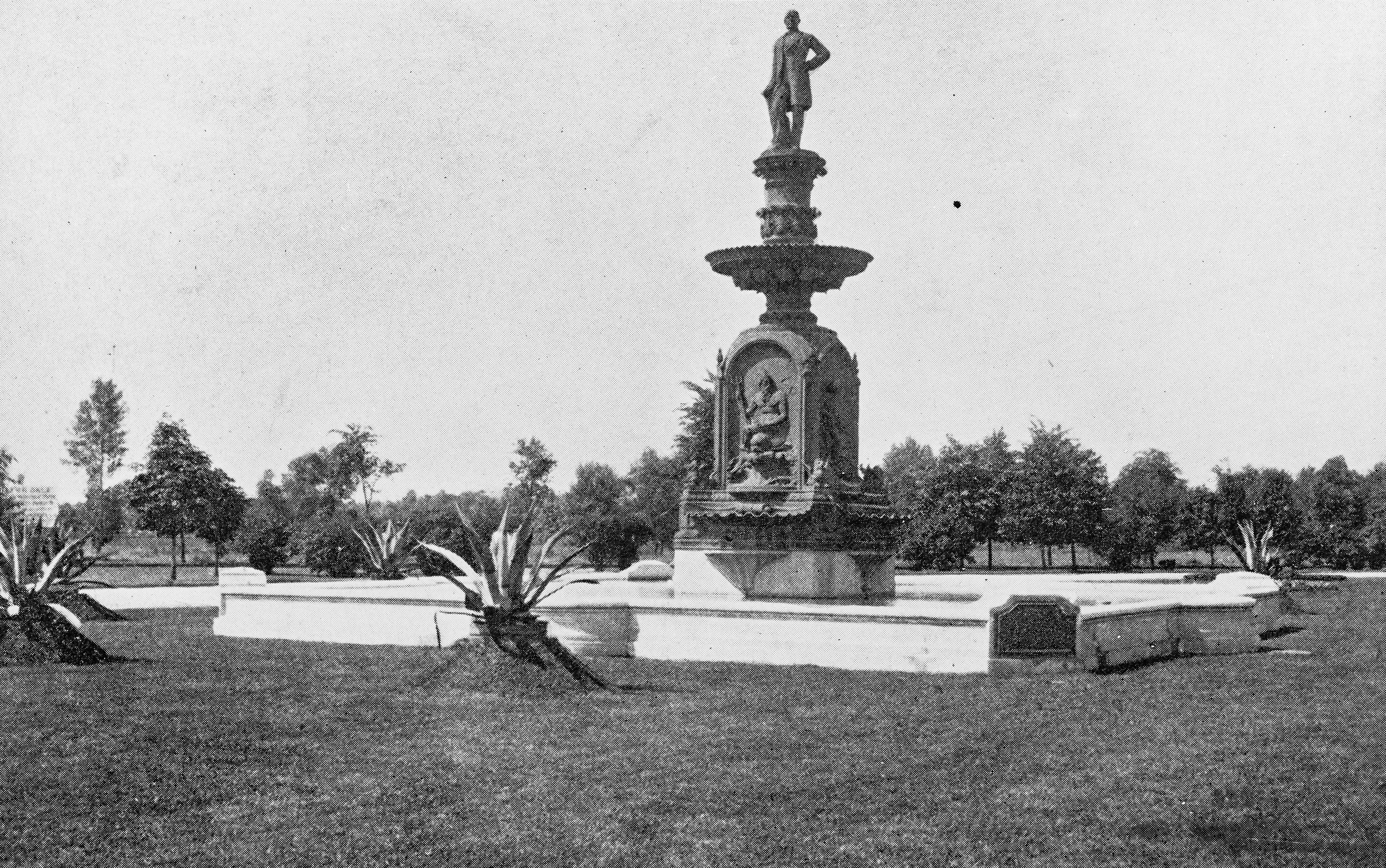
An early 20th century photograph of the Drexel Fountain in Chicago.
The Oldest Public Sculpture in a Chicago Park (Chicago, Illinois)
A historic piece of art in Chicago was donated by Anthony and his brother in the 1880s — and you can still see it today.
The Washington Drexel Fountain is the oldest existing public sculpture in a Chicago park (it's in Washington Park, hence the name). It features a sculpture of their father, Austrian painter-turned-banker and Drexel & Co. founder Francis Martin Drexel, who had opened a Drexel & Co. branch (Drexel & Smith) in Chicago shortly after the frontier town was incorporated in 1837. In addition to the Drexel Fountain, Chicago also celebrates the man who really never lived there with a Drexel Park, Drexel Boulevard and Drexel Avenue named in his honor.
A client who had purchased a large tract of land using a $50,000 Drexel & Smith loan had defaulted on payment, and the land reverted to the bank. After that section was laid out for development, it became the “Drexel & Smith subdivision,” and Francis donated part of it to the city to be used as a boulevard. The Drexel & Co. Chicago location had closed at some point before reopening in 1861 but closed for good after Francis Martin’s 1863 death.
Still, the Drexel connection remained in the city, particularly in what became known as the affluent Hyde Park neighborhood on the South Side of Chicago. In 1873, Francis Martin’s donated boulevard became the 200-foot-wide, 1.6-mile-long Drexel Boulevard. A 90-foot-wide median — designed by the same firm behind New York City’s Central Park — was built and filled with pathways, benches, trees and floral displays, which have been sustained to this day. Drexel Boulevard was a popular destination in a fashionable neighborhood; some of the lots the Drexel family still owned were sold to wealthy Chicagoans (Anthony’s will listed large tracts of land there worth several million dollars).
Francis Martin’s statue was erected in 1882 at a cost of $40,000 (about $1.26 million today), and Anthony and his older brother and Drexel & Co. partner Frank donated an additional $5,000 in 1888 (about $169,000 today) to enlarge a 36-by-36-foot pool. The tiered, bronze and granite fountain features a pedestal with four sculptural panels — one shows Neptune riding a dolphin — below a life-size sculpture of their father.
The designer, German sculptor Heinrich (Henry) Carl Johann Manger, later was commissioned by Philadelphia’s Canstatter Volksfest-Verein German-American club to design two bronze sculptures of German writers Friedrich Schiller and Johann Wolfgang von Goethe. They were installed in West Fairmount Park near a historic statue that Anthony had recently donated while president of the Fairmount Park Art Association (America’s first private and nonprofit public art organization).
All three Philadelphia sculptures can be seen today — and the Chicago one, too.
In This Article
Drexel News is produced by
University Marketing and Communications.
